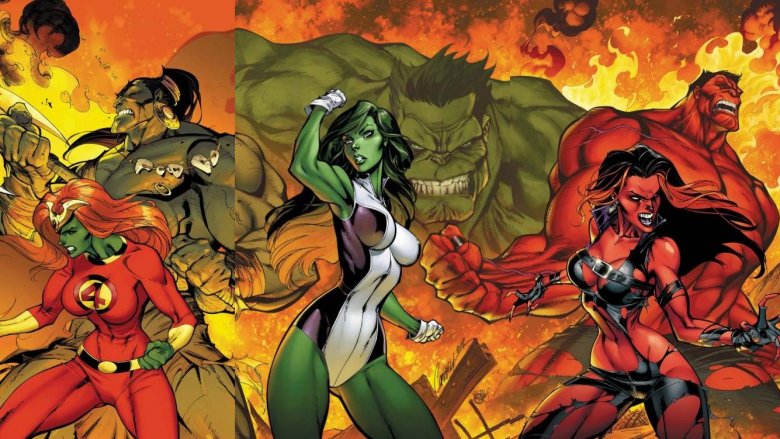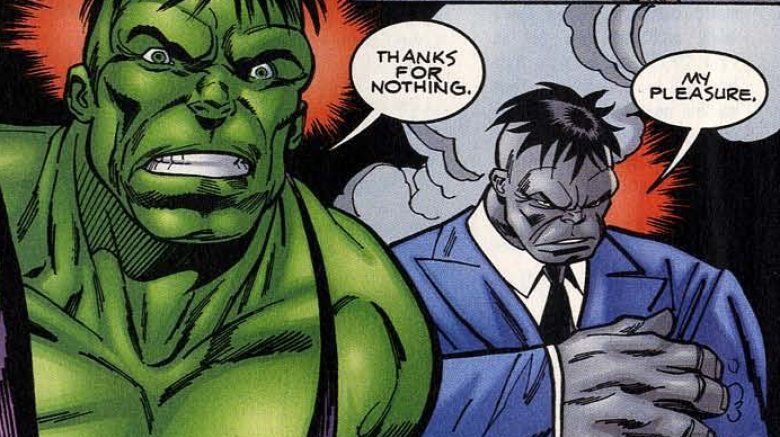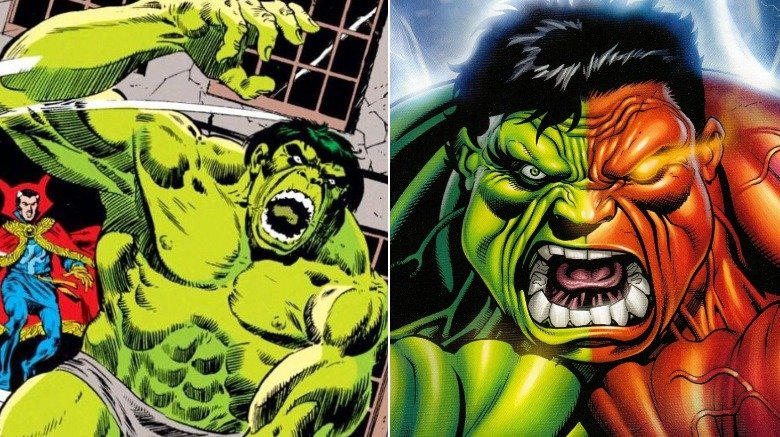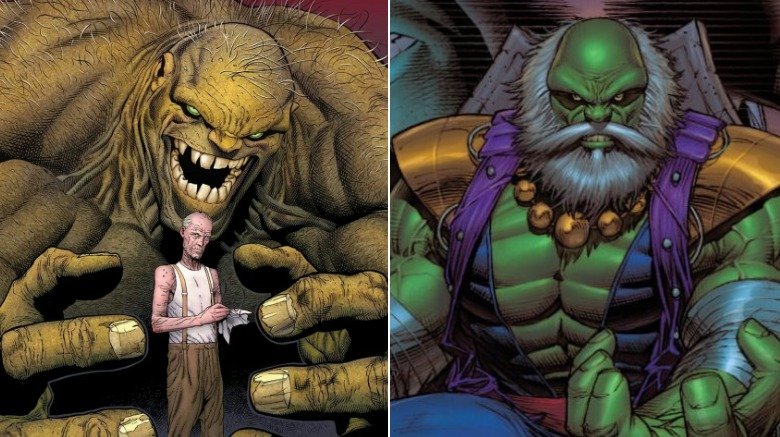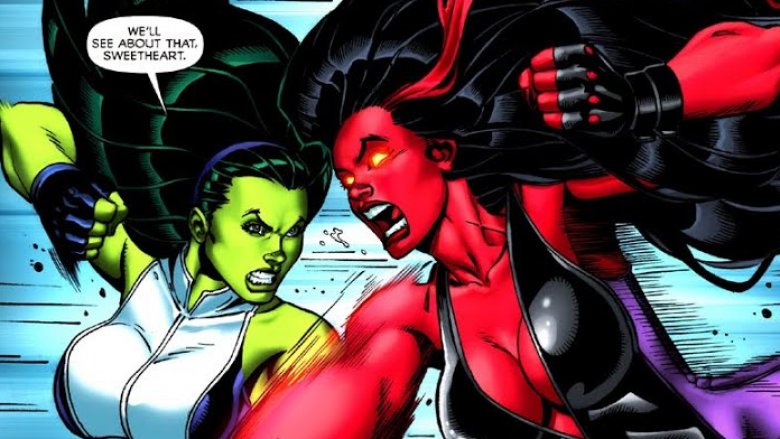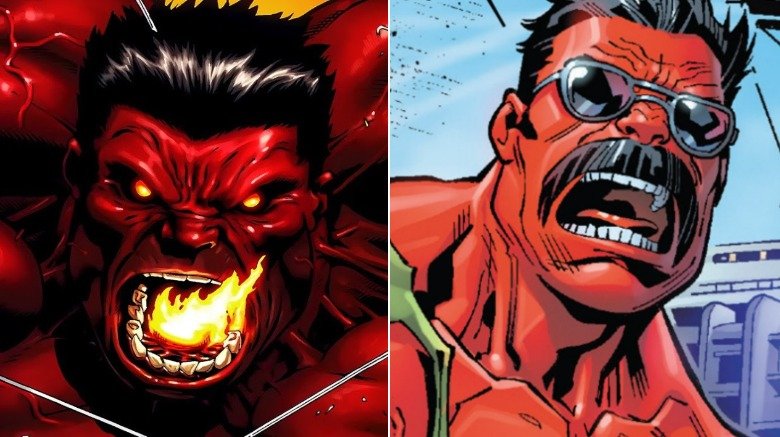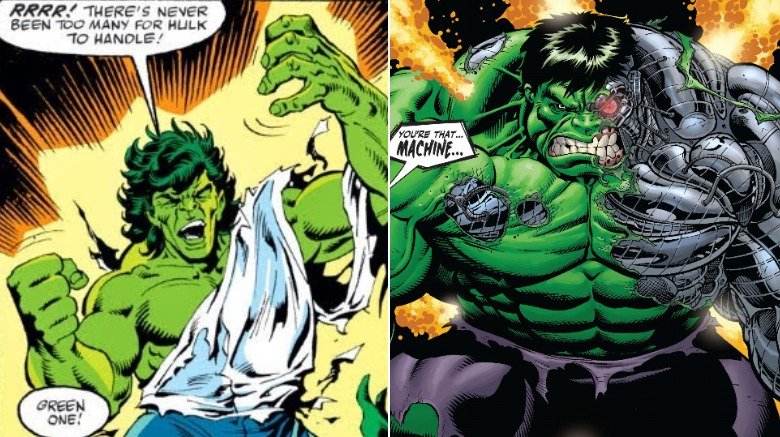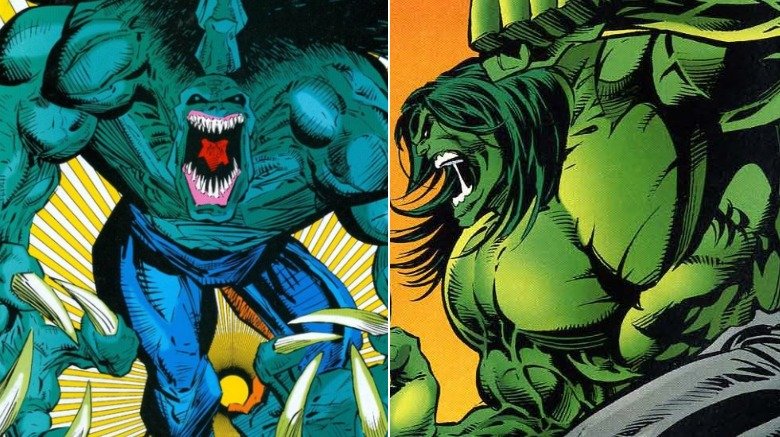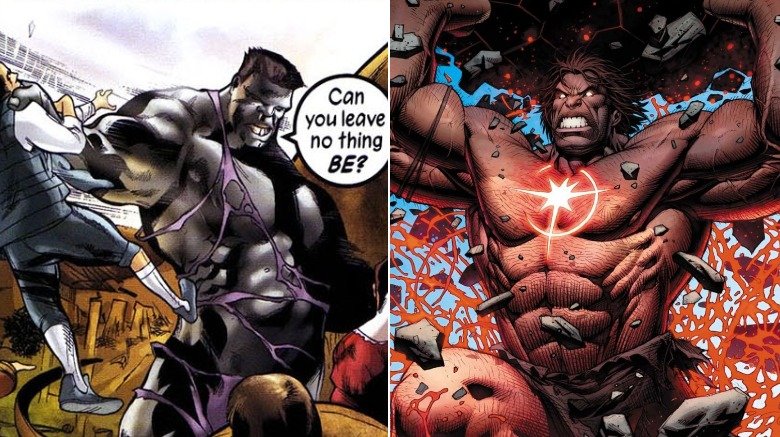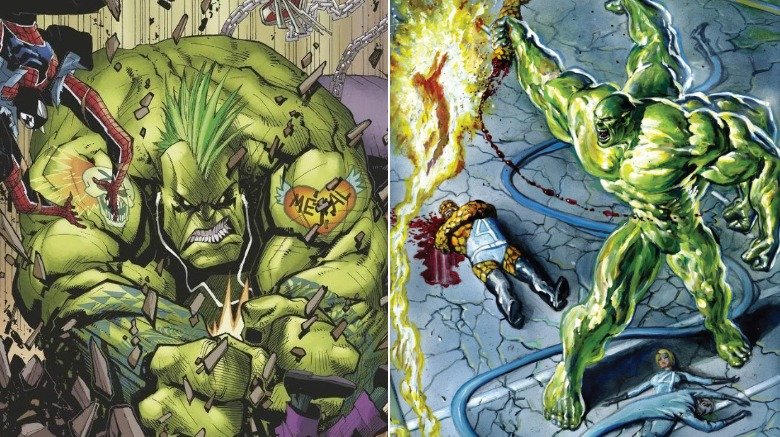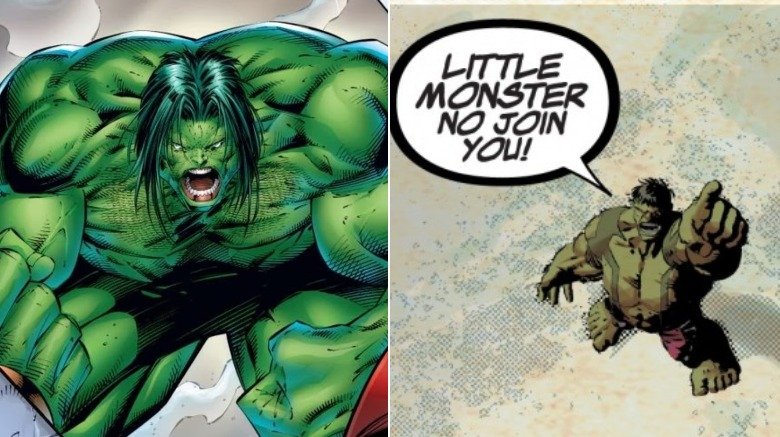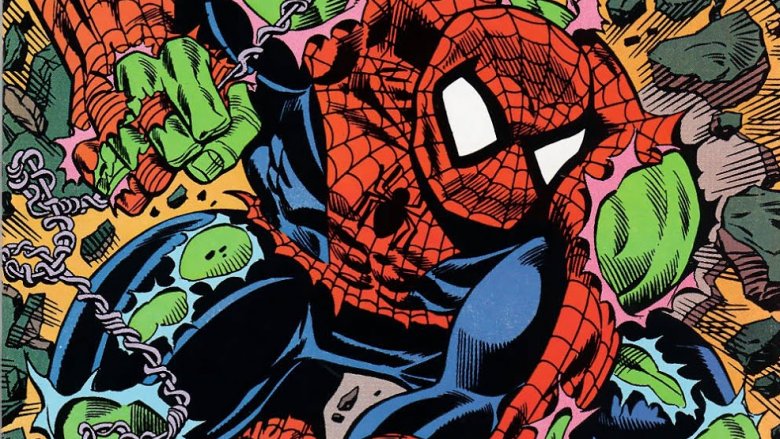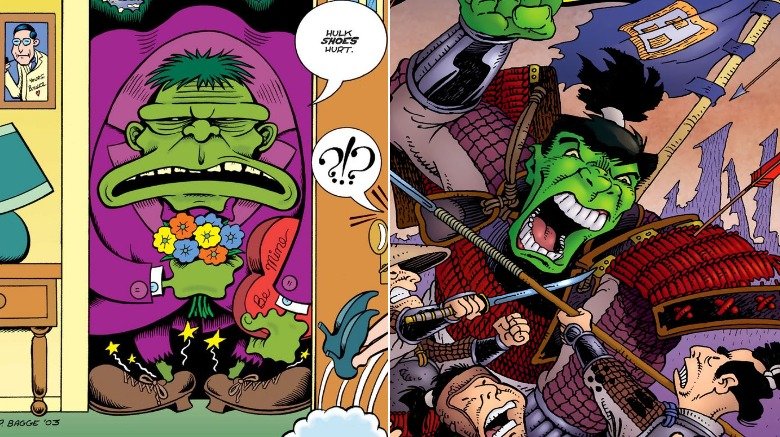The Many Hulks Of Marvel
You'd think one Hulk would be enough, right? He's big, he's practically invulnerable, he beats up thunder gods, and occasionally tries to smash the entire world.
Now, it doesn't take make research to figure out that Marvel and DC love making different versions of each of their heroes, particularly with the modern penchant of both companies to play with concepts like alternate realities and bleak, dystopian futures. Just play almost any Spider-Man video game, go through the list of alternate costumes, and it becomes clear just how much Marvel's storytellers enjoy exploring new twists on old characters.
This is particularly true for the Hulk. Perhaps because since he's unfortunately sometimes seen as little more than a big strong guy, Marvel's writers and artists have often treated him as blank a canvas as you get. The result is they've got green Hulks, gray Hulks, red Hulks, and blue Hulks. There are evil Hulks, robot Hulks, Hulks who are part rabbit, punk rock Hulks, pint-sized Hulks, and Hulks who say "Daddy-O" way more than is acceptable.
As much as we'd love to talk about each Hulk individually, there are so many different versions of the Hulk that if we took them one by one, we'd be here until Hulk 2099 turned into Hulk 3099. So we've had to consolidate a little, but we're confident you can still get a good look at the many Hulks of Marvel.
The many Hulks of Bruce Banner
In 1985's Incredible Hulk #312, longtime Hulk scribe Bill Mantlo told an origin story that established it was more than gamma radiation that created the Hulk. A young Bruce Banner endured horrible abuse from his father, and the Hulk was, in part, a manifestation of that trauma. Peter David later expanded upon this idea during his time on Incredible Hulk, establishing that the trauma created multiple Hulk personalities. Other writers added to this idea, including Paul Jenkins, who showed Banner had dozens of splintered Hulk personas.
The most recognizable is the Savage Hulk — the green, monosyllabic Hulk known for catch phrases like "HULK SMASH!" There is the gray Joe Fixit Hulk, who is intelligent, cunning, and sadistic, but not as powerful as other Hulks. The Professor — a variation of which appears in Avengers: Endgame – believed himself to be a merging of the Hulk's disparate personalities, but proved to be another splinter representing Banner's more rational, intellectual side. There is the so-called Grayvage Hulk — a version with the green skin, power, and myopic rage of the Savage Hulk but the cunning and intelligence of Joe Fixit. There is a massive Hulk representing Banner's guilt, a malevolent Devil Hulk who emerged as the dominant persona in the comic Immortal Hulk. There is even Savage Banner — the Savage Hulk personality, but in the body of Bruce Banner.
Altered Hulks
There are some versions of Bruce Banner's Hulk who exist not because of childhood trauma, but because of the influence of an outside source long after Banner's childhood was over.
Perhaps the most powerful example is the Mindless Hulk. Basically the Savage Hulk without any influence from Bruce Banner, he cannot speak even in the Savage Hulk's caveman-like speech, he has little or no moral compass, doesn't differentiate between friend or foe, and never reverts back to Bruce Banner's form. The Mindless Hulk is first seen in 1984's Incredible Hulk #299 as a result of the villain Nightmare's psychic manipulations. The resulting rampage is so destructive that Doctor Strange banishes the Hulk to another dimension. The Hulk goes mindless again in 1986's Incredible Hulk #315, when Bruce Banner and the Hulk are physically separated from one another by Doc Samson, though the two halves are reunited when it's learned both Hulk and Banner are dying without the other.
One of the most recent examples is Doc Green — a super-intelligent version of the Hulk who emerged after Extremis was used on Bruce Banner to save him from brain injury.
Perhaps the most outlandish of the altered Hulks is the Compound Hulk — a physical merging of the green and red Hulks by the cosmic troublemaker Impossible Man in 2011's Hulk #30.
Hulks who want to break the world
Even in his more intelligent incarnations, the Hulk tends not to play well with others. But there are some versions of the Hulk just as evil as any villain, bent on death and destruction and need no provocation to smash.
Most famously there's the Maestro — an evil, older, but more powerful version of the Hulk from a dystopian future introduced in the 1992-'93 miniseries Incredible Hulk: Future Imperfect. While he dies at the end of the series, he's made more recent appearances in Contest of Champions and Old Man Logan.
Speaking of Old Man Logan, the story that introduces the older version of Wolverine also features an Old Man Hulk. Allying himself with the world's villains, the Hulk carves out his own slice of America, and his children murder Logan's family.
Like other heroes and villains during the line-wide event Fear Itself, the Hulk is transformed into a darker version of himself — Nul, Breaker of Worlds. Years earlier, the villain Apocalypse is likewise able to coax a malevolent version of the Hulk to the surface by turning him into his Horseman of War. Joe Fixit's persona has its own dark mirror with Kluh, who surfaces in the line-wide event Axis, which sees many of Marvel's heroes and villains switch their traditional moral roles.
The females of the Hulk species
She-Hulk is getting a lot of attention these days because of the Disney+ series featuring the hero. The most well-known She-Hulk is Jennifer Walters — a successful lawyer and cousin to Bruce Banner who is transformed into the Savage She-Hulk after her cousin is forced to give her a blood transfusion. Initially, Walters transforms into her greener self based on anger just like her cousin, but as the years pass she evolves, and most versions of the character are able to control the shifts.
Shortly after the emergence of the Red Hulk, the Red She-Hulk appears, who proves to be the Hulk's wife Betty Banner. Red She-Hulk first appears as a villain, but eventually works on the side of the angels in Incredible Hulks, Defenders, and her own solo series. When Doc Green goes on a crusade to "cure" all gamma-powered individuals, he wipes out Red She-Hulk with Rick Jones' help, though in Immortal Hulk, Betty Banner becomes the Red Harpy.
Finally there's Lyra, the biological daughter of Hulk and the future hero Thundra. The latter travels into the past to get Hulk's DNA in order to give birth to a more powerful warrior, and Lyra is the result. Lyra enjoys her own series All-New Savage She-Hulk, but Doc Green accidentally banishes Lyra to another dimension during his anti-gamma crusade.
Red Hulks
The first Red Hulk is General Thaddeus "Thunderbolt" Ross — one of the original Hulk's oldest enemies. First appearing in 2008's Hulk #1, the Red Hulk's identity isn't revealed until 2010's Hulk #23 when we learn Ross agreed to let a group of villains calling itself the Intelligencia transform him into the Red Hulk so he could fight his old nemesis. He went back and forth between hero and villain, eventually joining the Avengers and leading a group of Thunderbolts. This Red Hulk was Doc Green's final target in his anti-gamma crusade and with the help of Deadpool, he succeeded in rendering Ross completely human.
The second Red Hulk is General Robert Maverick and, like the first Red Hulk, he would eventually be undone by the original. Maverick first appeared as this new Red Hulk in U.S.Avengers, though his powers worked differently from Ross'. Maverick could only become the Red Hulk for one hour per day, and eventually the original Hulk made sure he couldn't become the Hulk at all. In 2018's Avengers #685 — one issue after the original Hulk's resurrection — the green and red Hulks locked horns, resulting in the green Hulk absorbing all of General Maverick's gamma radiation into himself, leaving him human.
Hulks who have nothing to do with Bruce Banner
When the superhero Marvel Universe began, the Hulk was Bruce Banner. If it ever ends, the Hulk who exists at the end will likely be Bruce Banner. But in between, there have been a ton of Hulks who have nothing to do with the guy.
Amadeus Cho absorbs the gamma energy from Bruce Banner in 2015 to become the Totally Awesome Hulk, eventually losing most of that power. Along with being the blue-scaled A-Bomb and a newer, more frightening version of the Abomination, Rick Jones has been the Hulk twice. In 1978's What If? #12, Rick Jones was a Hulk who liked to say things like "Don't jive Hulk!" and "Hulk digs it!" Years later he would become a leaner, somewhat weaker Hulk in the prime Marvel continuity, but lose his powers when Joe Fixit siphoned his gamma energy into Sam Sterns, a.k.a. the Leader. The Hulk's son Skaar enjoyed both his father's powers and the stoneform abilities of his late mother Caiera, but was a victim of Doc Green's anti-gamma crusade and lost his Hulk powers.
Then there's the cosmic-powered Robot Hulk. The result of a science experiment gone haywire, the Robot Hulk first appears as an adversary to the Eternals in 1977's Eternals #14. Doctor Doom salvages it to interrupt the battle between Joe Fixit and the Thing in 1988's Incredible Hulk #350, and it shows up again when it's stolen by the Intelligencia in 2010's Fall of the Hulks: Alpha #1.
Hulks from tomorrow
There are many alternate reality versions of the Hulk, but in particular, there are a few versions of the Hulk from distant alternate futures.
When Marvel created futuristic versions of many of their heroes in the year 2099, the lineup included Hulk 2099. Appearing in his own title as well as the anthology series 2099 Unlimited, this bigger, fanged, and clawed version of the Hulk was Joe Eisenhart — a man gifted the gamma powers by a Hulk-worshipping cult calling itself the Knights of Banner.
Readers familiar with the first Old Man Logan story will remember it ends with the mutant taking a newborn son of Old Man Hulk under his care. In the miniseries Dead Man Logan, the older Wolverine is reunited with the child of Old Man Hulk who goes simply by "Bruce." He's not quite as strong as the original Hulk. He's very intelligent and prefers reading books to just about anything else, though you wouldn't know it by the way he speaks.
A lesser-known future Hulk shows up in 1997's Incredible Hulk #453 to try to talk sense into the present day Hulk, who has taken an island hostage. We don't learn much about this long-haired Hulk, though apparently in his timeline he is romantically involved with one of the present Hulk's military adversaries, Colonel Cary St. Lawrence.
Hulks from yesterday
Along with Hulks of the future, there are Hulks from the distant past, though not all of them are from alternate timelines.
The very end of Neil Gaiman's Marvel 1602 miniseries introduces a gray Hulk in the past. He spends most of the series as David Banner, adviser to King James I, not transforming until some of the final pages. Readers didn't get to see more of this early 17th century Hulk until the first sequel to the miniseries, 2005's Marvel 1602: New World.
During Marvel's 2017 Legacy event, it's revealed there was a prehistoric team of Avengers including Odin, Agomotto the first Sorcerer Supreme, a Ghost Rider riding mammoths instead of motorcycles, and a very Hulkish Star Brand. Introduced in Marvel's mid-'80s New Universe line of comics, the Star Brand later emigrated to the prime Earth-616 reality.
In the miniseries 5 Ronin, the Hulk is an otherwise peaceful monk in Edo-period Japan with the ability to change into a monster. One alternate reality from the miniseries 1872 hints at the existence of a wild west version of the Hulk, though sadly we never get to see him. Instead, in the final issue, we see an ominous Hulk-shaped footprint in the desert.
Hulks from alternate realities
Alternate realities are favorite stomping grounds for comic book creators, and as a result there are many alternate reality versions of the Hulk — too many possibly to mention, but we'll do our best.
Marvel's Ultimate line brought us a sadistic, cannibal Hulk strong enough to famously rip Wolverine in half. In the world of Earth X, Bruce Banner mutates to the point where he and the Hulk are physically separated but never apart. Banner is in the body of a young blind boy while the Hulk has taken on a large, ape-like appearance.
The Marvel Mangaverse features a Godzilla-sized Hulk. Edge of Spider-Geddon #1 introduces a Punk Rock Hulk from the same reality as Spider-Punk. The miniseries Bullet Points has a Peter Parker Hulk who dies battling Galactus. In Space: Punisher the Hulk is a four-armed monstrosity who murders the Fantastic Four and Deadpool, among others. What If General Ross Had Become the Hulk? #1 gives us a gray-skinned Ross Hulk three years before the Red Hulk shows up.
The end of the 2015 miniseries Planet Hulk reveals a Steve Rogers version of Doc Green. Another bizarre merging of the Hulk and Captain America is seen with an elite cadre of "Bannerman" soldiers in 2000's Marvel Boy #2.
And of course, there's the Zombie Hulk introduced in 2005's Ultimate Fantastic Four #22, who goes on in the many Marvel Zombies series to bite off Silver Surfer's head and crush Zombie Thanos' skull.
Hulks from other Earths
There are also some Hulks from other worlds which technically aren't considered alternate realities — at least not in the traditional sense.
As a result of the 1996 line-wide event Onslaught, a number of Marvel's heroes wind up in the "Franklin-Verse" — a pocket universe created by Franklin Richards, son of Reed and Sue Richards. The heroes' stories begin anew in the Heroes Reborn world with no memory of their old lives, while on their home Earth they're presumed dead. The Heroes Reborn Hulk is much like the Savage Hulk but with longer hair and more hostility toward that world's heroes, and he's often depicted as being naked (his naughty bits are covered in shadow).
More recently, the 2018 Infinity Wars event introduces a new, pint-sized Hulk called Little Monster. A separate universe is created within the Soul Gem which features heroes and villains who are combinations of other Marvel heroes. For example, Spider-Man and Moon Knight are combined to make Arach-Knight. Ghost Rider and Black Panther are merged to create Ghost Panther. Little Monster is Scott Banner — the merging of Ant-Man and the Hulk. Little Monster assists the nocturnal hero Sleepwalker in Infinity Wars: Sleepwalker and appears briefly in the 2019 event Secret Warps.
Hulked-Out heroes and villains
There are multiple examples of other heroes and villains briefly getting the Hulk's power, either accidentally or as part of their plans. One of the more well-known examples is the 2010 event World War Hulks which had heroes like Wolverine, Thor, Captain America, Deadpool, the Thing, and more become much Hulkier versions of their normal selves.
Another fan-favorite story gave us a brief shot of the Spider-Hulk. After being exposed to gamma radiation during a tussle with the Hulk in 1990's Web of Spider-Man #69, Peter Parker briefly becomes a green-skinned web-slinger in Web of Spider-Man #70. Though the change only lasted an issue, it was so memorable it spawned hard-to-find and expensive collectibles.
The evil space-faring villain Annihilus — fictional architect of Marvel's many Annihilation events — briefly gets a gamma power boost in the 2014's Thanos vs. Hulk miniseries, though as of yet this hasn't led to any high-priced Funko "Annihilus Hulk" bobbleheads.
Parody Hulks
The Hulk is a big, mostly naked green dude who often refers to himself in the third person and otherwise speaks like a caveman. If you can't find humor in that, then you need to lighten up. The Hulk is one of the most frequent targets of parody, and not just by comedians like Chris Farley or John Belushi. When Marvel creators get a chance to poke fun at the Green Goliath, they grab that bull by the green horns and they do it better than just about anyone else.
One example that fans were forced to wait for is Peter Bagge's Incorrigible Hulk. Originally solicited as its own miniseries, the title was cut before it saw the light of day but was eventually included in the miniseries Strange Tales. The same series gave plenty of Hulk funny, including James Kochalka's "The Hulk vs. Rain" with a frustrated Hulk trying and failing to punch a rainstorm, and the funny but tragic "Oni" by Stan Sakai, in which the samurai Sashimono Hulks out and smashes the lord he's sworn to protect. Pretty much any Marvel parody series will have plenty of Hulk humor, including the late '80s/early '90s comedy series What The –?!.
